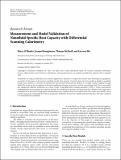| dc.contributor.author | Buongiorno, Jacopo | |
| dc.contributor.author | McKrell, Thomas J. | |
| dc.contributor.author | Hu, Lin-Wen | |
| dc.contributor.author | O'Hanley, Harrison F | |
| dc.date.accessioned | 2012-08-09T14:51:07Z | |
| dc.date.available | 2012-08-09T14:51:07Z | |
| dc.date.issued | 2011-10 | |
| dc.date.submitted | 2011-05 | |
| dc.identifier.issn | 1687-8132 | |
| dc.identifier.issn | 1687-8140 | |
| dc.identifier.uri | http://hdl.handle.net/1721.1/72068 | |
| dc.description.abstract | Nanofluids are being considered for heat transfer applications; therefore it is important to know their thermophysical properties accurately. In this paper we focused on nanofluid specific heat capacity. Currently, there exist two models to predict a nanofluid specific heat capacity as a function of nanoparticle concentration and material. Model I is a straight volume-weighted average; Model II is based on the assumption of thermal equilibrium between the particles and the surrounding fluid. These two models give significantly different predictions for a given system. Using differential scanning calorimetry (DSC), a robust experimental methodology for measuring the heat capacity of fluids, the specific heat capacities of water-based silica, alumina, and copper oxide nanofluids were measured. Nanoparticle concentrations were varied between 5 wt% and 50 wt%. Test results were found to be in excellent agreement with Model II, while the predictions of Model I deviated very significantly from the data. Therefore, Model II is recommended for nanofluids. | en_US |
| dc.language.iso | en_US | |
| dc.publisher | Hindawi Pub. Corp. | en_US |
| dc.relation.isversionof | http://dx.doi.org/10.1155/2012/181079 | en_US |
| dc.rights | Creative Commons Attribution | en_US |
| dc.rights.uri | http://creativecommons.org/licenses/by/2.0 | en_US |
| dc.source | Hindawi | en_US |
| dc.title | Measurement and Model Validation of Nanofluid Specific Heat Capacity with Differential Scanning Calorimetry | en_US |
| dc.type | Article | en_US |
| dc.identifier.citation | O’Hanley, Harry et al. “Measurement and Model Validation of Nanofluid Specific Heat Capacity with Differential Scanning Calorimetry.” Advances in Mechanical Engineering 2012 (2012): 1–6. Web. | en_US |
| dc.contributor.department | Massachusetts Institute of Technology. Department of Nuclear Science and Engineering | en_US |
| dc.contributor.department | MIT Nuclear Reactor Laboratory | en_US |
| dc.contributor.approver | Buongiorno, Jacopo | |
| dc.contributor.mitauthor | O'Hanley, Harrison F. | |
| dc.contributor.mitauthor | Buongiorno, Jacopo | |
| dc.contributor.mitauthor | McKrell, Thomas J. | |
| dc.contributor.mitauthor | Hu, Lin-Wen | |
| dc.relation.journal | Advances in Mechanical Engineering | en_US |
| dc.eprint.version | Final published version | en_US |
| dc.type.uri | http://purl.org/eprint/type/JournalArticle | en_US |
| eprint.status | http://purl.org/eprint/status/PeerReviewed | en_US |
| dspace.orderedauthors | O'Hanley, Harry; Buongiorno, Jacopo; McKrell, Thomas; Hu, Lin-wen | en |
| mit.license | PUBLISHER_CC | en_US |
| mit.metadata.status | Complete | |
